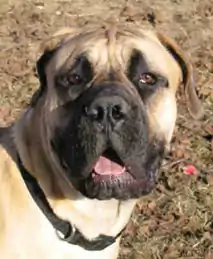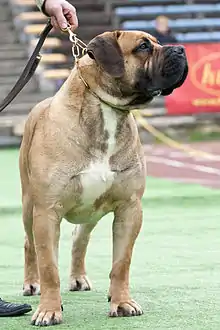Boerboel
The Boerboel [ˈbuːrbul], is a large, mastiff-type dog from South Africa with a black mask and a short coat.[1] This dog breed is large with a strong bone structure and well developed muscles. Its head appears blocky with a short length between the stop and nose. It carries itself with a confident and powerful movement, is fearless and shows courage when threatened.[3]
| Boerboel | |||||||||||||||||||||||||||||
|---|---|---|---|---|---|---|---|---|---|---|---|---|---|---|---|---|---|---|---|---|---|---|---|---|---|---|---|---|---|
 | |||||||||||||||||||||||||||||
| Other names | South African mastiff[1] | ||||||||||||||||||||||||||||
| Origin | South Africa | ||||||||||||||||||||||||||||
| Foundation stock | Mastiffs & bulldogs | ||||||||||||||||||||||||||||
| |||||||||||||||||||||||||||||
| |||||||||||||||||||||||||||||
| Notes | SABBS Breed Standard | ||||||||||||||||||||||||||||
| Dog (domestic dog) | |||||||||||||||||||||||||||||
Breed history
The name Boerboel derives from the Afrikaans words boer which means farmer, and "boel" which is a shortening of "boelhond" which means bulldog.[4]
One historical source dated 1909 describes events in 1857, when a cross between a bulldog and a mastiff referred to as the "Boer Hunting Dog" was the best dog for hunting leopards and baboons in packs. A leopard that is caught in a trap by one leg can be killed by a pack of these dogs, but in one case a dog was badly injured.[5] The "Boer mastiff" is described as an excellent fighter, with one managing to kill a leopard in each of four single combats over a number of years before being killed himself in the fifth encounter.[6] However, the boerboel is not a deterrent for a leopard, and a leopard will kill and carry away a large dog such as a boerboel or a rottweiler; it is an indication that a leopard is in the area.[7]
In remote areas of South Africa the Boerboel was kept by the white population to protect their families and property in their homes and on their farms.[8]
The Boerboel was first introduced to purebred enthusiasts throughout the world, including the United States, by the American anthropologist Dr. Carl Semencic, first in an article in Dog World Magazine and later in his book entitled Gladiator Dogs which was first published by T.F.H. Publications in 1998 and later republished by another publisher in 2013. Semencic credits his early familiarity with the breed to his own travels to South Africa, but especially to his frequent correspondence with the head of the first South African Boerboel club, one Mr. Kobus Rust. Later, the Boerboel Breeders Association was established in 1983 in the Senekal district of the Free State with the sole objective of ennobling and promoting the Boerboel as a unique South African dog breed.
Legislation
In South Africa, the Animal Improvement Act (62 of 1998) defines a breed of animal indigenous to or developed in the republic to be a landrace,[9] therefore the boerboel is regarded as a landrace in the republic.[10] The Act grants powers to a registered "animal breeders society", and the South African Boerboel Breeders’ Society (SABBS) is a registered animal breeders society.[11] The SABBS is the only organisation authorised under the Act to officially register Boerboels. As legally registered custodian of the Boerboel dog breed, SABBS is responsible for the standards that govern identification, recording, evaluation and improvement of the breed.[10][12] The Kennel Union of South Africa still recognises those Boerboels registered on its books.[12]
Description


The boerboel is a large dog, with a strong bone structure and well developed muscles. The head appears blocky, but not overdone, with a short length between the stop and nose. It should look impressive, carrying himself with confidence and powerful movement, which should be buoyant, and unencumbered, despite its size. It should be symmetrical and balanced, following the desired proportions for the breed.[3]
The coat is short and sleek with dense hair coverage. The recognised colours are brindle, fawn, and brown. There is one minor divergence between breed standards; the Kennel Union of South Africa does not accept black[3] but SABBS does.[2]
Temperament
The boerboel is fearless and shows courage when threatened, and requires training and firm handling from an early age.[3] It is not unusual for this breed to display aggression toward other dogs or strangers.[13]
A boerboel requires a significant commitment in time and energy as they need to be trained and properly socialized in order to be happy, well-adjusted family members.[14]
These dogs thrive under positive reinforcement training techniques and require human companionship and structure. If left isolated, Boerboels will digress and may become destructive. Forcefully controlling the dog is detrimental to their psychological health and could cause potential behavioral backlash in the future. These dogs benefit from an owner who respects their size and strength but is not fearful of it.
Although more suited to large yards, boerboels are adaptable as long as they receive regular exercise and a lot of attention but can struggle with living in small environments. Whatever the amount of space available, they need to have plenty of physical and mental exercise.[14]
Health
Boerboels are generally known for their good health. However, Boerboels can suffer from hip[15] or elbow dysplasia, vaginal hyperplasia,[16] ectropion, and entropion.[14] Recently, juvenile epilepsy (with attacks brought on by metabolic changes or stress) has appeared in the boerboel breed.[17] A boerboel's behavior and comportment may change over time.[18] The average life expectancy is ten to twelve years.[19]
Restrictions

In 2002, Romania prohibited the import of the Boerboel, and restricted ownership to those with a court order allowing them to own the dog.[20]
In 2010, the Boerboel was banned in Denmark.[21]
In 2011, Russia designated the Boerboel an "especially dangerous breed," subject to mandatory registration and certification.[22]
Ukraine has classified the Boerboel as a dangerous dog, subject to mandatory microchipping, muzzle, and civil liability insurance.[23]
The Boerboel is also banned or prohibited in:
Importation of the Boerboel is illegal/banned in:
- Singapore—currently existing dogs must have insurance in the amount of not less than $100,000, sterilization, microchipping, and muzzle.[30]
- Denmark—currently existing dogs must be muzzled and leashed at all times in public.
- Romania—owners must be at least 18 years of age, and be certified psychologically fit to own a dog of this breed.
- Tunisia [31]
- Faroe Islands [32]
- Turks and Caicos[33]
See also
References
- Studdert, Virginia P.; Gay, Clive C.; Blood, Douglas C. (2011). Saunders Comprehensive Veterinary Dictionary. Saunders. p. 139. ISBN 978-0-7020-4743-5.
- SABBS Breed Standard
- Boerboel breed standard, Kennel Union of South Africa, retrieved 15 October 2020
- Afrikaans-English, English-Afrikaans Dictionary Jan Kromhout (2001) Hippocrene Books, pp 24-25
- A South African (February 1909). "The Boer Hunting Dog". Agricultural Journal of the Cape of Good Hope. 34 (2): 186–188. hdl:10520/AJA0000018_1086.
- Standard Encyclopaedia of Southern Africa, Capetown. South Africa, 1971. Volume 4, page 57
- Mac, Dr (7 May 2016). "Protecting horses against leopards". Farmers Weekly. Retrieved 15 October 2020.
Dogs are not a deterrent for leopards. In fact, they are preferred prey. A leopard will easily kill a large dog such as a Rottweiler or Boerboel and carry it away. An indicator of a leopard in the area is when many dogs go missing within a relatively short time.
- Morris, Desmond (2001). Dogs: the ultimate guide to over 1,000 dog breeds. North Pomfret, VT: Trafalgar Square Publishing. pp. 618–619. ISBN 1-57076-219-8.
- Animal Improvement Act Government of South Africa 1998
- SABBS homepage
- {https://www.gov.za/sites/default/files/gcis_document/201411/38188gen980.pdf REGISTRATION OF ANIMAL BREEDERS' SOCIETY]
- A brief history of the Boerboel in Southern Africa - KUSA
- "Breed standard" (PDF).
- Breed description, UK Boerboel Club, archived from the original on 17 April 2012, retrieved 6 September 2014
- "New Hip Dysplasia Grading System sabt.co.za 3 June 2007" (PDF). Archived from the original (PDF) on 1 October 2011. Retrieved 18 September 2012.
- "Vaginal hyperplasia sabt.co.za 12 July 2007" (PDF). Archived from the original (PDF) on 1 October 2011. Retrieved 18 September 2012.
- Stassen, Quirine E. M.; Grinwis, Guy C. M.; van Rhijn, Nieke C.; Beukers, Martjin; Verhoeven‐Duif, Nanda M.; Leegwater, Peter A. J. (2019). "Focal epilepsy with fear‐related behavior as primary presentation in Boerboel dogs". Journal of Veterinary Internal Medicine. 33 (2): 694–700. doi:10.1111/jvim.15346. PMC 6430876. PMID 30580458.
- Wade, John (29 May 2010). "High-end lifetime training is mandatory". Sarnia Observer. Archived from the original on 14 April 2016. Retrieved 2 April 2016.
- Lynne Berridge (2004). "Accolade Boerboels". Boerboels.co.uk. Retrieved 18 September 2012.
- "List of Banned Dogs by Countries". petolog.com. Retrieved 28 July 2015.
- Ritzau /Nyheder, Mette Pedersen (19 January 2011). "Ekstra Bladet - 13 kamphunde forbydes". Ekstrabladet.dk. Retrieved 18 September 2012.
- "List of Banned Dogs by Countries".
- "List of Banned Dogs by Countries". petolog.com. Retrieved 3 August 2015.
- "Pet Breeds unable to travel in Europe". www.viajedemascotas.com. Retrieved 3 August 2015.
- "U.S. List of Banned Breeds". www.terrificpets.com. Retrieved 3 August 2015.
- "Importing a cat or dog - Doha Family - Autumn 2014". www.dohafamily.com. Retrieved 3 August 2015.
- "Banned Dog Breeds in Switzerland - Documents". Retrieved 3 August 2015.
- "Mauritius Pet Passport - Current Dog and Cat Import Requirements". www.pettravel.com. Retrieved 3 August 2015.
- "Banned, restricted dogs breed reminder | The Royal Gazette:Bermuda News". Retrieved 3 August 2015.
- "List of Banned Dogs by Countries". petolog.com. Retrieved 3 August 2015.
- "IATA - Tunisia Customs, Currency & Airport Tax regulations details". www.iatatravelcentre.com. Retrieved 3 August 2015.
- "It is prohibited to import the following dogbreeds to the Faroe Islands" (PDF). Archived from the original (PDF) on 24 September 2015.
- "Turks Caicos Pet Passport - Current Dog and Cat Import Requirements". www.pettravel.com. Retrieved 3 August 2015.
Further reading
- Hancock, David (2001). The mastiffs: the big game hunters, their history, development & future. Ducklington, Oxon: Charwynne Dog Features. ISBN 9780951780114.
- Verhoef-Verhallen, Esther J. J. (2001). The complete encyclopedia of dogs. The Netherlands: Rebo International. pp. 530–531. ISBN 90-366-15097.
